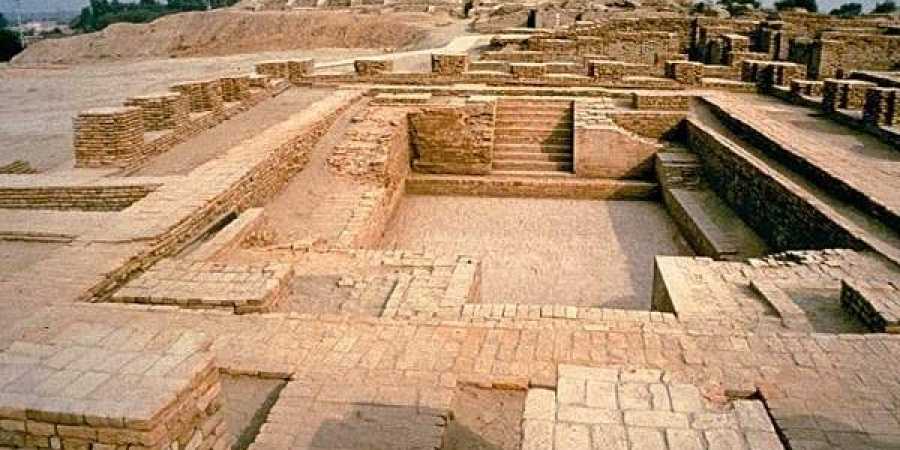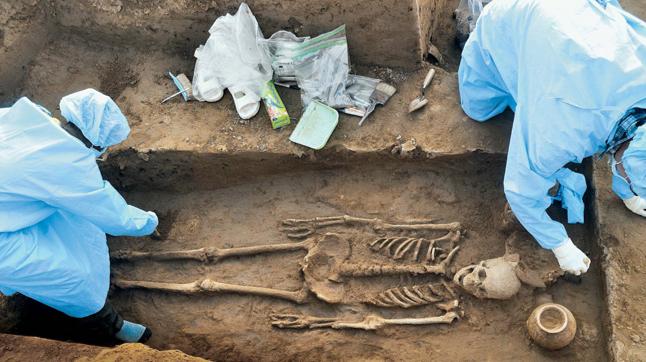- Indus Valley Civilization is a collection of all the civilizations that existed along the Indus river and the Ravi river. It was not a single city spread over lacs of miles
Southern-most site of IVC: 𝗗𝗮𝗶𝗺𝗮𝗯𝗮𝗱 (MH)
Eastern-most site of IVC: 𝗔𝗹𝗮𝗺𝗴𝗶𝗿𝗽𝘂𝗿 (UP)
Western-most site of IVC: 𝗦𝘂𝘁𝗸𝗮𝗴𝗲𝗻𝗱𝗼𝗿 (Pak-Iran border)
-Early Harappan Phase from 3300 to 2600 BCE (Harka Phase)
- Mature Harappan Phase from 2600 to 1900 BCE
- Late Harappan Phase from 1900 to 1300 BCE
By 2600BCE IVC appeared in the mature stage.
- Harappa and Mohenjodaro had its citadel, which was possibly the area of members of the ruling class.
- Lower towns were laid out in a rectangular grid pattern containing brick houses occupied by the common working-class people.
- Quality of town planning suggests the knowledge of urban planning
-Burial system– Wooden coffin, Respect to the body, No. of pots observed
- Situated near flood plains
- Wheat, barley (Punjab), Barley(Rajasthan); Millets(Gujarat), Rice cultivation ( Lothal & Rangpur only)
- Earliest people to produce cotton
- Bull was known
- Ploughed field surface (pre Harappan @ Kalibangan)
- Traces of canals at the Harappan site of Shortughai in Afghanistan
- Animals were also reared on a large scale
- Presence of numerous seals, uniform script and regulated weights and measures
- Trade-in stone, metal, shell, etc
-Trade by the barter system.
- No metal Money used
- Dockyard at Lothal
- Trade-in Lapis lazuli
- Items Exported- Agate, Quality wood, Ivory Boxes, Pottery, Cotton, Copper, etc
-Long route trade was made possible by advances in the transportation technology at that time
- The Harappans were very well acquainted with the manufacturing and use of Bronze.
- Copper from Khetri copper mines of Rajasthan
- Tin was possibly brought from Afghanistan.
- Textile impressions found on several objects.
- Terracotta manufacture was also an important craft.
- The goldsmiths made jewelry of silver, gold, and precious stones.
- Single centralized authority
- No evidence that they followed orders from someone.
- No temples/Palace
- More inclined towards trade; peaceful political life
- Socially stratified
- Mirror and comb evidence
- Use of copper, silver, gold beads
- Agate and carnelian- semi-precious stones
- Evidence of chess and Dice
- Seals- mostly square seals, triangular, circular also found
- Steatite soft stone- most common material for seals
- Bi-directional writing style (Boustrophedon), pictographic script
- No evidence of cow
- The lion was not known to Indus people
- Seals with hole found on dead bodies – Used as amulets
- Made using Lost wax techniques(Cire Perdue)
- Wax figures coated with wet clay—Clay coated figures heated—Wax melted inside—wax poured out thr. small hole and insertion of liquid metal—after solidification metal figure of the same shape obtained.
- Both men and women wore ornaments
- Bead making factories at lothal and chanhudaro
- Cotton and wool for fabric
- Conscious of fashion – different styles of beard and hairs
- Bearded Priest- draped in shawl, half closed eyes, armlet
Many possibilities predicted by archaeologist
- Possibility of epidemics
- Floods Silt on house -->>repeated flood leads to migration of people
- Earthquake as in seismographic zone
- Change in course of the river
- The Rigveda speaks of a battle at a place named "Hariyumpia" which has been identified with Harappa.
-In Rigveda river Saraswati is also mentioned which could have been another name or tributary to Indus river
- paper titled “An Ancient Harappan Genome
Lacks Ancestry from Steppe Pastoralists and
Iranian Farmers” questioned on Aryan Invasion Theory
Find paper at - pubmed.ncbi.nlm.nih.gov/31495572/
- National Museum, New Delhi
-Harappa.com
-Hindustanmerijaan.com
- Indian Art & Cuture by Nitin Singhania
- Indian Art & Culture by Gaurav Agarwal



















